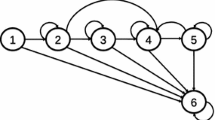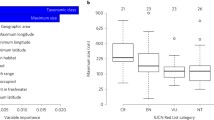Abstract
Distributional change, expressed as range expansion or contraction , has been observed in many marine populations and related to changes in the environment. The extent of such distributional changes is also expected to increase in response to future climate change. The Benguela Current Large Marine Ecosystem (BCLME) which adjoins the south-western coast of Africa is a global marine hotspot with long-term warming occurring over a large area. The area is also an important centre of marine food production for three countries—South Africa, Namibia and Angola and is considered to be vulnerable to future climate change or increased climate variability. In this study we analysed change in distribution and range size of several demersal fish species in the BCLME over the period 1985–2010, including both commercial and non-commercial fish populations. Some of the observed changes in distribution and range size correspond to what is expected with increased warming whereas others appear to the contrary. Overall the results of the study highlight the complex nature of the response of fish population to climate change.









Similar content being viewed by others
References
Axelsen BE, Johnsen E (in press) An evaluation of the bottom trawl suyrveys in the Benguela Current Large Marine Ecosystem. Fish Oceanogr
Bacheler NM, Bailey KM, Ciannelli L, Bartolino V, Chan KS (2009) Density-dependent, landscape, and climate effects on spawning distribution of walleye pollock Theragra chalcogramma. Mar Ecol Prog Ser 391:1–12
Bakun A (1996) Patterns in the ocean: ocean processes and marine population dynamics. University of California Sea Grant Program, San Diego, California, USA, in cooperation with Centro de Investigaciones Biologicas de Noroeste, La Paz, Mexico
Beare D, Burns F, Jones E, Peach K, Portilla E, Greig T, Mckenzie E, Reid D (2004a) An increase in the abundance of anchovies and sardines in the northwestern North sea since 1995. Glob Chang Biol 10:1209–1213
Beare D, Burns F, Jones E, Peach K, Kienzle M, Greig T, Mckenzie E, Reid D (2004b) Long term increase in the prevalence of north fishes having southern biogeographic affinities. Mar Ecol Prog Ser 284:269–278
Beaugrand G, Edwards M, Brander K, Luczak C, Ibanez F (2008) Causes and projections of abrupt climate-driven ecosystem shifts in the North Atlantic. Ecol Lett 11(11):1157–1168
Belkin IM (2009) Rapid warming of large marine ecosystems. Prog Oceanogr 81:207–213
Bianchi G (1999) Field guide to the living marine resources of Namibia. Food & Agriculture Organization
Blanchard F, Vandermeirsch F (2005) Warming and exponential abundance increase of the sub-tropical fish Capros aper in the Bay of Biscay (1973–2002). C R Biol 328:505–509
Boyer DC, Hampton I (2001) An overview of the living marine resources of Namibia. S Afr J Mar Sci 23:5–35
Coetzee JC, van der Lingen CD, Hutchings L, Fairweather TP (2008) Has the fishery contributed to a major shift in the distribution of South African sardine? ICES J Mar Sci 65:1676–1688
Crawford RJM, Dyer BM, Kemper J, Simmons RE, Upfold L (2007) Trends in numbers of Cape Cormorants (Phalacrocorax capensis) over a 50-year period, 1956–57 to 2006–07. Emu 107:253–261
Dulvy NK, Rogers SI, Jennings S, Stelzenmuller V, Dye SR, Skjoldal HR (2008) Climate change and the deepening of North Sea fish assemblages: a biotic indicator of warming sea. J Appl Ecol 45:1029–1039
Fairweather TP, Booth AJ, Sauer WHH, Leslie RW (2006) Spatial description of hake directed fishing activity off the west coast of South Africa. Afr J Mar Sci 28:13–24
Froese R, Pauly D (eds) (2012) FishBase. World Wide Web electronic publication. www.fishbase.org (version 02/2012)
Genner MJ, Sims DW, Southward AJ, Budd GC, Masterson P, McHugh M, Rendle P, Southall EJ, Wearmouth VA, Hawkins SJ (2010) Body size dependent response of a marine fish assemblages to climate change and fishing over a century-long scale. Glob Chang Biol 16:517–527
Hamukuaya H, O’Toole MJ, Woodhead PMJ (1998) Observations of severe hypoxia and offshore displacement of Cape hake over the Namibian shelf in 1994. S Afr J Mar Sci 19:57–59
Heileman S, O’Toole MJ (2009) I-1 Benguela Current: LME #29. LME Briefs. www.lme.noaa.gov
Hutchings L, van der Lingen CD, Shannon LJ, Crawford RJM, Verheye HMS, Bartholomae CH, van der Plas AK, Louw D, Kreiner A, Ostrowski M, Fidel Q, Barlow RG, Lamont T, Coetzee J, Shillington F, Veitch J, Currie JC, Monteiro P (2009) The Benguela Current: an ecosystem of four components. Prog Oceanogr 83(1):15–32
Johnsen E, Kathena J (2012) A robust method for generating separate catch time-series for each of the hake species caught in the Namibian trawl fishery. Afr J Mar Sci 34:43–53
Kirkman SP, Yemane D, Oosthuizen WH, Meÿer MA, Kotze PGH, Skrypzeck H, Vaz Velho F, Underhill LG (2012) Spatio-temporal shifts of the dynamic Cape fur seal population in southern Africa, based on aerial censuses (1972–2009). Mar Mam Sci. doi:10.1111/j.1748-7692.2012.00584.x
Kirkman SP, Yemane D, Kathena J, Mafwila S, Nsiangango S, Samaai T, Axelsen B, Singh L (2013) Identifying and characterizing of demersal biodiversity hotspots in the BCLME: relevance in the light of global changes. ICES J Mar Sc 70(5):943–954
Last PR, White WT, Gledhill DC, Hobday AJ, Brown R, Edgar GJ, Pecl G (2011) Long-term shifts in abundance and distribution of a temperate fish fauna: a response to climate change and fishing practices. Glob Ecol Biogeogr 20(1):58–72
Lorenzen K, Enberg K (2001) Density-dependent growth as a key mechanism in the regulation of fish populations: evidence from among population comparison. Proc R Soc Lond B 269:49–54
MacCall AD (1990) Dynamic geography of marine fish populations. University of Washington Press, Seattle
Mafwila SK (2011) Ecosystem effect of bottom trawling in the Benguela current system: experimental and retrospective analysis. PhD Thesis, University of Cape Town
Maronna RA, Martin RD, Yohai VJ (2006) Robust statistics: theory and methods. Wiley, London
O’Toole MJ, Shannon LV, de Barros Neto V, Malan D (2001) Integrated management of the Benguela Current region—a framework for future development. In: von Bondungen B, Turner RK (eds) Science and integrated coastal management. Dahlem University Press, Dahlem, pp 229–251
Parmesan C (2006) Ecological and evolutionary responses to recent climate change. Ann Rev Ecol Evol Syst 37:637–669
Perry AL, Low PJ, Ellis JR, Reynolds JD (2005) Climate change and distribution shifts in marine fish populations. Science 308:1912–1915
Pitcher GC, Calder D (2000) Harmful algal blooms of the Southern Benguela: a review and appraisal of monitoring from 1989 to 1997. S Afr J Mar Sci 22:255–271
Planque B, Fromentin J-M, Cury P, Drinkwater KF, Jennings S, Perry IR, Kifany S (2010) How does fishing affect marine populations and ecosystems sensitivity to climate change? J Mar Syst 79:403–417
Portner HO (2010) Oxygen- and capacity-limitation of thermal tolerance: a matrix of integrating climate-related stressors effects in marine ecosystems. J Exp Biol 6:881–893
Portner HO, Knust K (2007) Climate change affects marine fishes through oxygen limitation of thermal tolerance. Science 315:95–97
Poulard JC, Balanchard F (2005) The impact of climate change on the fish community structure of the eastern continental shelf of the Bay of Biscay. ICES J Mar Sci 62:1436–1443
Richardson AJ, Schoeman DS (2004) Climate impact on plankton ecosystems in the Northeast Atlantic. Science 305:1609–1612
Rijnsdorp AJ, Peck MA, Engelhard GH, Mollman C, Pinnegar JK (2010) Resolving the effects of climate change on fish populations. ICES J Mar Sci 66:1570–1583
Rindorf A, Lewy P (2006) Warm, windy winters drive cod north and homing of spawners keep them here. J Appl Ecol 43:445–453
Rouault M, Penven P, Pohl B (2009) Warming in the Agulhas current system since the 1980s. Geophys Res Lett 36. doi:10.1029/2009GL037987
Rousseeuw P, Christophe C, Valentin T, Andreas R, Matias S-B, Tobias V, Manuel K, Martin M (2012) Robustbase: basic robust statistics. R package version 0.8-1-1. http://CRAN.R-project.org/package=robustbase
Shannon LV (1985) The Benguela ecosystem: evolution of the Benguela, physical features and processes. Ocean Mar Biol Annu Rev 23:105–182
Shannon LV, O’Toole MJ (2003) Sustainability of the Benguela: ex Africa semper aliquid novi. In: Hempel G, Sherman K (eds) Large marine ecosystems of the world—trends in exploitation, protection and research. Elsevier, Amsterdam, pp 227–253
Shannon LV, Hempel G, Malanotte-Rizzoli P, Moloney CL, Woods J (2006) Benguela: predicting a large marine ecosystem: predicting a large marine ecosystem, vol 14. Elsevier, Amsterdam
Shillington FA, Reason CJC, Duncombe Rae CM, Florenchie P, Penven P (2006) Large scale physical variability of the Benguela Current Large Marine Ecosystem (BCLME). Large Mar Ecosyst 14:49–70
R Core Team (2012) R: a language and environment for statistical computing. R Foundation for Statistical Computing, Vienna, Austria. ISBN 3-900051-07-0, http://www.R-project.org/
Utne-Palm AC, Salvanes AGV, Currie B, Kaartvedt S, Nilsson GE, Braithwaite VA, Stecyk JAW, Hundt M, van der Bank M, Flynn B, Sandvik GK, Klevjer TA, Sweetman AK, Brüchert V, Pittman K, Peard KR, Lunde IG, Strandabø RAU, Gibbons MJ (2010) Stability in an overfished ecosystem. Science 329:333–336
van der Lingen CD, Shannon LJ, Cury P, Kreiner A, Moloney CL, Roux J-P, Vaz-Velho F (2006) 8 Resource and ecosystem variability, including regime shifts, in the Benguela Current System. Large Mar Ecosyst 14:147–184
Venables WN, Ripley BD (2002) Modern applied statistics with S. Springer, New York
Worm B, Tittensor DP (2011) Range contraction in large pelagic predators. PNAS 308:11942–11947
Acknowledgments
The authors would like to acknowledge contributions of regional institutes (Fisheries Management branch of DAFF in South Africa, NatMirc of Namibia, and INIP of Angola) that supported this study and made data available, and NORAD for supporting the NANSCLIM project and facilitating meetings of the demersal task team. The authors would also like to thank the two anonymous reviewers and editor of this special issue for their invaluable comments and suggestions that improved the manuscript.
Author information
Authors and Affiliations
Corresponding author
Appendices
Appendix 1
In this appendix the list of species that showed significant changes in the four indices of distribution are presented in tables for each country. The tables also contain the exploitation status of each species (Tables 2, 3, 4)
.
Appendix 2
The depth and latitudinal coverage of sampling stations during a routine bottom trawl survey are presented in Figs. 10, 11, 12, 13, 14 and 15. Figure 10 shows the distribution of sampling depth of the surveys in South Africa for each year with the exception of 1989 the survey sampling depth covers relatively the same depth range. Figure 11 shows the distribution of sampling latitude of the surveys in South Africa for each year with the exception of 1989 the survey sampling latitude covers relatively the same latitude range. With the exception for the first few years the depth range of the sampling stations off Namibia remained the same (Fig. 12). Similarly the latitudinal coverage of the sampling stations remained the same except for 1995 where it only covered a smaller area of the typical survey region. The latitudinal and depth coverage of the sampling stations off Angola are shown in Figs. 14 and 15 respectively. With the exception of the early sampling years both the depth and latitudinal range of sampling stations remained relatively the same.
Rights and permissions
About this article
Cite this article
Yemane, D., Kirkman, S.P., Kathena, J. et al. Assessing changes in the distribution and range size of demersal fish populations in the Benguela Current Large Marine Ecosystem. Rev Fish Biol Fisheries 24, 463–483 (2014). https://doi.org/10.1007/s11160-014-9357-7
Received:
Accepted:
Published:
Issue Date:
DOI: https://doi.org/10.1007/s11160-014-9357-7










